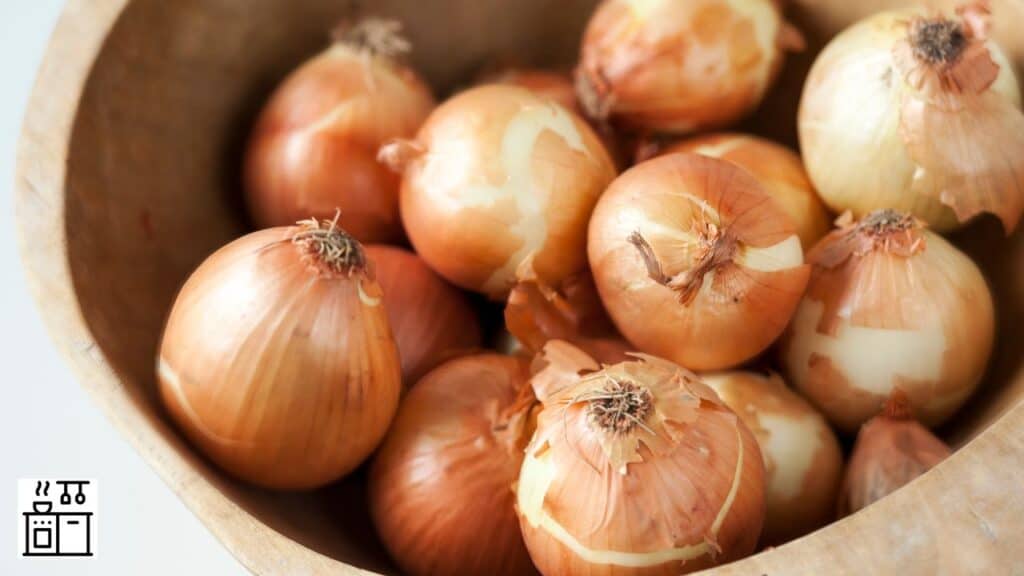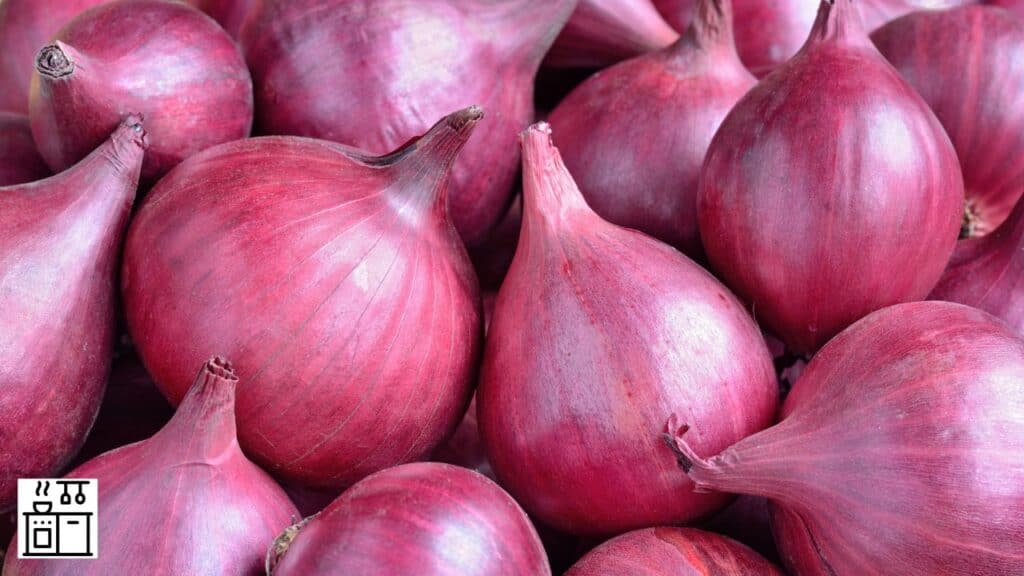Onions have a wide range of flavors, ranging from sweet to savory and spicy.
Sweet onions are widely used in salads, sandwiches, and vegetable platters.
However, some recipes focus on the savory and spicy characteristics of onions.
Let’s look at which onions are best suited for such needs.
6 Onions That Aren’t Sweet
The sweetness of onions depends on how much sugar and sulfur they contain.
Onions with more sulfur compounds are pungent.
Although they contain natural sugars, their sulfur levels make them more pungent than sweet.
The sulfur content varies across onions.
Sulfur also builds up in an onion when it spends more time underground.
So, the bigger an onion, the longer it has been under the soil, and hence the higher its sulfur content.
Such onions will be pungent and make you cry when you chop them.
Let’s look at some of these onions.
1. White Onions
White onions are a staple ingredient in Mexican cooking.
However, these onions are rarer than yellow and red onions.
They have sharp flavors and look very attractive.
As the name suggests, these onions have white papery skin and white flesh beneath the skin.
They’re pungent with just a hint of sweetness. These onions are filled with moisture and are juicy.
White onions add a good bite to dishes.
The juiciness of these onions combines with their crunchy texture to create a beautiful balance.
They’re usually sharper and more pungent than other onion varieties.
Raw white onions are used for cooking and can be added raw to salads and sandwiches.
They’re included in the garnish for various Latin and Central American dishes.
You will find these onions in salsas, guacamole, taco fillings, and salads.
However, they are used in small amounts because of their strong flavor.
Eating too many raw white onions on their own can be overwhelming.
You can cook white onions just like you would cook yellow or brown onions.
They’re also good for pickling and grilling.
2. Red Onions
Red onions are very versatile because they’re both sweet and spicy.
Some varieties are stronger and very pungent. Others are mild enough to be eaten raw.
Nonetheless, most types of red onions have a strong sharpness that cuts through their sweetness.
These onions have strong flavors and are very pungent.
Cooks often chill them before chopping or drop them in water for some time to make them easier to chop.
These onions have an attractive and distinct purple-red color due to the presence of anthocyanins and anthoxanthins in their skin.
Red onions add a lovely color to many dishes when used in raw form.
The bright red color reduces upon cooking as heat breaks down the color-inducing pigments.
However, they will not lose their color when cooked in an acidic medium.
These onions are widely used as a base for various recipes.
They have peppery and spicy flavors.
They do well in salads and sandwiches and can also be used in dishes like stews, casseroles, and baking recipes.
They’re also good for grilling and roasting because their flavors intensify when heated.
Red onions also look very beautiful in pickles, where their bright red color shines through.
Since most varieties of red onions don’t have too much sugar content, they don’t brown when cooked.
They will instead turn translucent and become soft.
Recommended: A Complete List Of Sweet Onions | 15 Unique Tomatoes That Grow in Clusters | Potato Varieties With Dirt-Like Taste
3. Green Onions
Green onions or scallions are immature or baby onions.
They have an elongated and spindly structure that is different from other onion varieties.
They resemble long green grass-like stalks with a purple and white bulb-like base.
Tiny roots stick out of the bulb at the base.
They’re widely used in salads, stir-fry recipes, and garnishes for fried rice and other dishes.
The hollow green stalks, as well as the white bulbs, can be used for cooking.
They’re a popular ingredient in Chinese cooking.
Green onions are milder than regular onions. The green tips are barely sweet.
However, the white ends with the roots are very pungent.
These onions don’t add any sweetness to a dish.
The leafy part will wilt away during cooking, so you should only cook them mildly.
Green onions don’t hold up as well as other varieties of onions.
The green part has a short shelf-life, and storing them for too long can make them wilt.
The base will also turn slimy and smell if stored for too long.
Hence, you should store them in the refrigerator if you won’t be using them immediately.
4. Yellow Onions

Yellow onions are the most commonly available onions in the market.
They’re also called brown onions because these onions usually have brown papery skin.
Once you peel off the outer brown skin, these onions have yellowish-white flesh.
These onions are versatile and work in most recipes.
These onions have higher sulfur levels than white onions.
Hence, they will produce tears while chopping. Depending on the variety, they can grow very big.
The larger the onion, the more sulfur it will have built up.
Yellow onions also develop complex flavors. They have a good balance of pungency and mild sweetness.
Yellow onions are good for cooking.
They add more texture to a dish and turn dark brown upon cooking.
The sharpness of the onion reduces with cooking.
Yellow onions are very versatile ingredients.
The most commonly available variety of yellow onions is yellow globe onions.
These are fist-sized with thick and juicy flesh. They’re most commonly used in soups, sauces, and stews.
Due to their high sulfur content, these onions aren’t the best choice for salads and other dishes requiring raw onions.
5. Ramps
Ramps are a type of wild onion that is native to North America.
The structure is similar to that of spring onions with thick and luscious green leaves on a purple stalk, with a white bulb-like structure at the base.
All parts of a Ramp can be eaten. It tastes more like garlic than onion in raw form.
Raw ramps are used to make pesto.
The flavors of ramps change slightly when cooked. Their sharpness mellows and becomes slightly sweeter.
You can use this vegetable in the same way as scallions or green onions.
Due to the presence of foliage, they don’t keep for a long time.
Store them in the refrigerator and use them up quickly.
Related: Which Freezers Work In Cold Garages? | Does A Mini Refrigerator Has A Freezer?
6. Chives
Chives are technically not onions.
They’re classified as herbs with basil and parsley but are abundantly used in a variety of recipes.
However, their flavor and taste are similar to onions.
Chives look like scallions or green onions. However, they’re thinner and more delicate.
Another significant difference between chives and green onions is that the bulbous part of chives is also green, like the stalk.
Meanwhile, the bulb part is white in green onions.
Chives have a mild onion flavor. Some varieties, like garlic chives, taste more like garlic than onions.
You can chop them finely and sprinkle them on potatoes, eggs, Ramen, soup, and stir-fry.
You can also cook and bake with them.
They add a delicious onion-like pungency to recipes.
Although they taste like onions, they lack the sweetness that most onions have.

